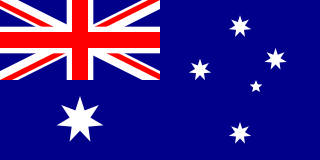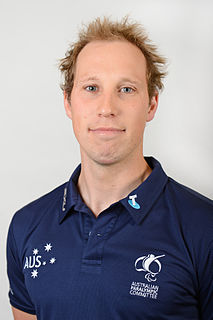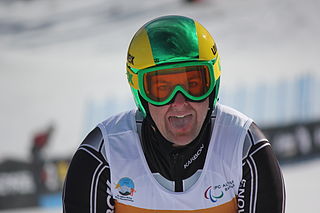
Michael John Milton, OAM is an Australian Paralympic skier, Paralympic cyclist and paratriathlete with one leg. With 6 gold, 3 silver and 2 bronze medals he is the most successful Australian Paralympic athlete in the Winter Games.
Alpine skiing at the 2002 Winter Paralympics consisted of 53 events, 34 for men and 19 for women which all took place at the Snowbasin Ski Area.
Alpine skiing at the 1998 Winter Paralympics consisted of 54 events, 35 for men and 19 for women.

Alpine skiing at the 1994 Winter Paralympics, in Lillehammer (Norway), consisted of 66 events, 46 for men and 20 for women.

Alpine skiing at the 1992 Winter Paralympics consisted of 48 events, 30 for men and 18 for women.
Alpine skiing at the 1988 Winter Paralympics consisted of 44 events, 29 for men and 15 for women.
Alpine skiing at the 1984 Winter Paralympics consisted of 56 events, 34 for men and 22 for women.

The United States sent a delegation to compete at the 1984 Winter Paralympics in Innsbruck, Austria.

The 1984 Winter Paralympics, then known as The Third World Winter Games for the Disabled, were held in Innsbruck, Austria. The games took place from the 15 until 21 January. Present at these games were 419 athletes from 21 countries, Spain and the Netherlands competing for the first time in the Winter Paralympics, competing in 107 events across 3 sports. The inclusion of Les Austres and Cerebral palsy impairment groups contributing to the distinct increase in athlete participation with the total number of athletes jumping from 229 at Geilo, Norway in 1980.

The 2011 IPC Alpine Skiing World Championships was held in Sestriere, Italy, from January 14 to 23, 2011. IPC stands for International Paralympic Committee.

Australia sent a delegation to compete at the 1988 Winter Paralympics in Innsbruck, Austria, which was held between 17–24 January 1988. This marked the nation's fourth appearance at the Winter Paralympics. The delegation sent a group of five alpine skiers as they wouldn't get a medal in these games.

Australia competed at the 1992 Winter Paralympics in Tignes and Albertville in France. They were the first winter Paralympics to be celebrated concurrently with the Olympic Games. The official logo of the Games was designed by Jean-Michel Folon. It depicts a bird with broken wings, soaring high across the peak of a mountain. This was used to reflect the sporting abilities of the athletes at the Games. The official mascot, Alpy, designed by Vincent Thiebaut, represented the summit of the Grande Motte mountain in Tignes. Alpy was shown on a mono-ski to demonstrate its athleticism and the colours of white, green and blue were used to represent purity/snow, hope/nature and discipline/the lake. The 1992 Games were where Australia won their first winter medals at the Paralympics. Michael Milton won Australia's first gold with a win in the Men's Slalom LW2. Milton also won a silver medal in the Men's Super G LW2. At these Games, Australia was represented by 5 male athletes. Australia was placed 12th in the overall medal tally for the Winter Games winning a total of 4 medals: 1 gold, 1 silver and 2 bronze.

Australia competed at the 2002 Winter Paralympics in Salt Lake City, Utah, United States from 8 March to 19 March 2002. The Salt Lake Paralympics are the eighth such winter games, the first Winter Paralympics ever in North America and the first Winter Paralympics ever set up by an Olympic organizing committee. Although many of the Paralympic expenses were covered by dual planning with the Olympics, organizers still spent about $60 million on the Paralympics, including $5 million on the opening and closing ceremonies. The Salt Lake Games featured 92 events across four sports: alpine skiing, biathlon, cross-country, and ice sledge hockey. The 36 competing countries sent a total of 416 participants. Australia was represented by six male alpine skiers: Peter Boonaerts, Bart Bunting, Michael Milton, Scott Adams, Cameron Rahles-Rahbula, and Mark Drinnan. The medal haul was seven, consisting of six gold and one silver. Australia finished 8th overall in the gold and total medal count, making it the country's most successful Winter Games in terms of gold medals.

Cameron Rahles-Rahbula is a former Paralympic alpine skier from Australia. He won two bronze medals at the 2010 Winter Paralympics in Vancouver. He represented Australia in four Paralympics, stating with the 2002 Winter Paralympics in Salt Lake City and the 2006 Winter Paralympics in Torino. He did not compete in any events at the 2014 Winter Paralympics in Sochi due to knee and ankle injuries suffered during the warm up for the downhill event of the Games but carried the Australian flag in the Parade of Nations at the Opening Ceremony. He also won two gold medals and a silver medal at the 2004 IPC Alpine Skiing World Championships in Wildschönau, Austria, and a gold and a bronze medal at the 2009 World Championships in Jeongseon, Korea. He retired after the Sochi Games.
LW12 is a para-Alpine and para-Nordic sit skiing sport class defined by the International Paralympic Committee (IPC). An LW12 skier needs to meet a minimum of one of several conditions including a single below knee but above ankle amputation, monoplegia that exhibits similar to below knee amputation, legs of different length where there is at least a 7 centimetres difference, combined muscle strength in the lower extremities less than 71. For international competitions, classification is done through IPC Alpine Skiing or IPC Nordic Skiing. For sub-international competitions, classification is done by a national federation such as Alpine Canada. For para-Alpine, this class is subdivided into two subclasses.: LW12.1 and LW12.2. A new sit-skier competitor with only national classification will compete as LW12.2 in international competitions until they have been internationally classified.

LW1 is a para-Alpine standing skiing classification for people with severe lower extreme disabilities in both extremities. It includes both skiers with amputations and cerebral palsy. International classification is done through International Paralympic Committee Alpine Skiing, and national classification through local national sport federations. LW1 classified skiers use outriggers, and two skis or one ski with a prosthesis. Other equipment is used during training such as ski-tips, ski-bras, and short skis.

LW2 is a para-Alpine and para-Nordic standing ski sport class defined by the International Paralympic Committee (IPC). Competitors in this class have severe disability in a lower limb, which may be a result of an amputation, or arthrodesis in the leg and hip. Depending on the type of skiing, the international classification process for LW2 skiers is handled by the IPC Alpine Skiing Technical Committee and IPC Nordic Skiing Technical Committee. National sport federations handle classification on the lower levels.
LW4 is a para-Alpine and para-Nordic standing skiing sport class defined by the International Paralympic Committee (IPC) for skiers who may have a disability in one lower extremity, which may be a result of a leg amputation below the knee, knee arthrodesis or a hip arthrodesis. For international skiing competitions, classification is done through IPC Alpine Skiing or IPC Nordic Skiing. A national federation such as Alpine Canada handles classification for domestic competitions.

The 2015 IPC Alpine Skiing World Championships was an international disability sport alpine skiing event held in Panorama Mountain Village, British Columbia, Canada from March 2 to 10, 2015. The Championship is held biannually by the International Paralympic Committee (IPC) and is the largest event of its type outside the Winter Paralympics.

The 2013 IPC Alpine Skiing World Championships was an international disability sport alpine skiing event held in La Molina ski resort in Spain from 18 to 27 February 2013. The Championship is held biannually by the International Paralympic Committee (IPC) and is the largest event of its type outside the Winter Paralympics.



















